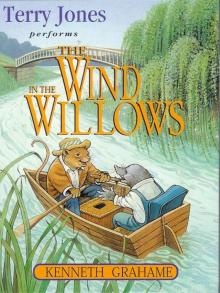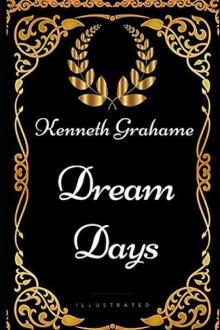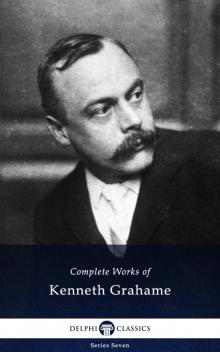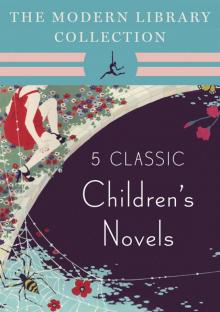- Home
- Kenneth Grahame
The Modern Library Children's Classics
The Modern Library Children's Classics Read online
The Wind in the Willows, Alice’s Adventures in Wonderland & Through the Looking-Glass, Peter Pan, and The Three Musketeers are works of fiction. Names, places, and incidents either are products of the author’s imagination or are used fictitiously.
A Modern Library eBook Edition
The Wind in the Willows Introduction copyright © 2005 by Jeffrey Moussaieff Masson
Biographical note and reading group guide copyright © 2005 by Random House, Inc.
Alice’s Adventures in Wonderland & Through the Looking-Glass Introduction copyright © 2002 by A. S. Byatt
Notes, biographical note, and reading group guide copyright © 2002 by Random House Inc.
Grateful acknowledgement is made to Carcanet Press Limited for permission to reprint eight lines from “Alice” from Complete Poems by Robert Graves.
Reprinted by permission of Carcanet Press Limited.
Peter Pan Introduction copyright © 2004 by Anne McCaffrey.
Biographical note and reading group guide copyright © 2004 by Random House Inc.
The Three Musketeers copyright ©1950, 1978 by Random House, Inc.
Biographical note copyright ©1996 by Random House, Inc.
Introduction copyright ©2001 by Alan Furst
All Rights Reserved.
Published in the United States by The Modern Library, an imprint of The Random House Publishing Group, a division of Random House, Inc., New York.
Modern Library and colophon are registered trademarks of Random House, Inc.
The novels contained in this omnibus were each published separately by The Modern Library, an imprint of The Random House Publishing Group, a division of Random House, Inc., in 2005, 2002, 2004, and 1996.
Cover painting: Mari Katogi
eBook ISBN 978-0-8129-8447-7
www.modernlibrary.com
v3.1
Contents
Cover
Title Page
Copyright
The Wind in the Willows
Alice’s Adventures in Wonderland
Peter Pan
The Three Musketeers
(photo credit 1.1a)
2005 Modern Library Paperback Edition
Introduction copyright © 2005 by Jeffrey Moussaieff Masson
Biographical note and reading group guide copyright © 2005
by Random House, Inc.
All rights reserved.
Published in the United States by Modern Library,
an imprint of The Random House Publishing Group,
a division of Random House, Inc., New York.
MODERN LIBRARY and the TORCHBEARER Design are
registered trademarks of Random House, Inc.
LIBRARY OF CONGRESS CATALOGING-IN-PUBLICATION DATA
Grahame, Kenneth
The wind in the willows / Kenneth Grahame; introduction by Jeffrey
Moussaieff Masson; illustrations by Paul Bransom. —Modern Library pbk. ed.
p. cm.—(The Modern Library classics)
eISBN: 978-0-307-82040-2
1. Animals—Fiction. 2. England—Fiction. 3. Friendship—Fiction.
4. River life—Fiction. 5. Country life—Fiction. I. Title. II. Series.
PR4726.W515 2005
821’.8—dc22 2004055991
Modern Library website address:
www.modernlibrary.com
Frontispiece: The Piper at the Gates of Dawn.
v3.1
CONTENTS
Master - Table of Contents
The Wind in the Willows
Title Page
Copyright
ILLUSTRATIONS
INTRODUCTION by Jeffrey Moussaieff Masson
THE WIND IN THE WILLOWS
I. The River Bank
II. The Open Road
III. The Wild Wood
IV. Mr. Badger
V. Dulce Domum
VI. Mr. Toad
VII. The Piper at the Gates of Dawn
VIII. Toad’s Adventures
IX. Wayfarers All
X. The Further Adventures of Toad
XI. “Like Summer Tempests Came His Tears”
XII The Return of Ulysses
READING GROUP GUIDE
BIOGRAPHICAL NOTE
ILLUSTRATIONS
1.1a The Piper at the Gates of Dawn.
1.1 It was the Water Rat.
2.1 “Come on!” he said. “We shall just have to walk it.”
3.1 In panic, he began to run.
4.1 Through the Wild Wood and the snow.
6.1 Toad was a helpless prisoner in the remotest dungeon.
8.1 He lay prostrate in his misery on the floor.
9.1 “It’s a hard life, by all accounts,” murmured the Rat.
11.1 Dwelling chiefly on his own cleverness, and presence of mind in emergencies.
12.1 The Badger said, “Now then, follow me!”
INTRODUCTION
Jeffrey Moussaieff Masson
Before The Wind in the Willows, there were animal fables, such as Aesop’s, which Kenneth Grahame much loved and wrote an introduction to. There were also animal stories, including Beatrix potter’s Peter Rabbit—in fact, Grahame had given his son pet rabbits named Peter and Benjie in that book’s honor. But there had never been an animal novel.
The Wind in the Willows is the first animal novel ever written. The point of view is pure anthropomorphism, blatantly, obviously, and charmingly so: “When they got home, the Rat made a bright fire in the parlour, and planted the Mole in an arm-chair in front of it, having fetched down a dressing-gown and slippers for him, and told him river stories till supper-time.” What child would ever exclaim, “Preposterous!” as the London critics did?
Imagine accusing a child of anthropomorphism because she is telling herself a story about animals who talk. Perhaps there really was a time when parents and educators would reprimand a child with: “Animals don’t talk. Nor do they think. Nor do they feel. So stop all this foolishness!” Back in 1908 when The Wind in the Willows was first published, a witless reviewer in The Times Literary Supplement complained that “as a contribution to natural history the work is negligible” (as if that were Kenneth Grahame’s purpose) and that a water rat would “never use a boat to navigate a stream.”1
Children, of course, never made such a criticism, either in the past or now. This is not, I think, because children are more sophisticated literary critics than the reviewer in the Times; it is rather that children use their imaginations to form intense and somewhat mysterious bonds with animals that most adults consider beneath their dignity to ponder—rats, badgers, toads, and others—and are not generally thought of as cuddly “pets.”
Would the Wind in the Willows have attained the immortal status it now enjoys if the book had been identical in every way except one: instead of animals its characters were people? The answer is obvious. The animals are somehow integral to the enduring charm of the book. How can we explain this? I think part of the answer lies in the value of anthropomorphism. Far from being a problem to be solved or, even worse, a sin to be avoided, anthropomorphism is and always has been embraced by children the world over. In every tradition I know, animals are present in children’s stories with attributes that the authors, and the children, know perfectly well those animals do not possess.
In other words, children recognize the value of extending one’s imagination right into the life of a creature of another species. Children know that we can enter the inner world of another animal, or indeed even another person, only if we are willing to suspend disbelief, to employ our empathy, our sympathy, and above all, our imagination. This is valuable for reading literature, for writing it, and even fo
r conducting scientific research, as we have belatedly begun to recognize. Call that anthropomorphism if you will; it is a position animal scientists are only recently coming to hold.
A more modern critic might attack Grahame for the sin of “sentimentalism,” since what Grahame achieves is to capture some of the feelings children have when around real animals, and then project them successfully into this fantasy of perfect peace, harmony, comfort, and safety. His world is infused with not just animal activity but also animal feelings, unusual for the time and even for now.
The animals in The Wind in the Willows speak to children more directly than they do to adults because of this instant ability children have to suspend judgment and disbelief. There are no parents in any of Kenneth Grahame’s writings, perhaps because he lost his mother when he was six years old and was abandoned shortly thereafter by his father. Parents are not to be trusted; indeed, humans are not. Grahame did not choose animals by accident. Animals and places would not disappoint. Critics have noted that it is safest, in Grahame’s world, to invest emotions in places, especially home. Rat, Mole, Toad, and Kenneth Grahame himself are moved by a nostalgic longing to return to or recover their homes. Three times in The Wind in the Willows Grahame describes a particular home, and especially notes such qualities as cozy warmth, comfort, and safety from predation by humans and other animals.
Of course, it’s peculiar that the animals in the book are all male, single, and have no family ties or obligations of any kind. Sexuality does not exist in this world (as indeed it barely did for Grahame). This was deliberate on Grahame’s part. In a letter of October 10, 1908, to President Theodore Roosevelt, who had expressed his love of the book, Grahame told him, “[The Wind in the Willows’s] qualities, if any, are mostly negative—i.e.—no problems, no sex, no second meaning.”2
Some adults, especially writers for children, did understand and admire what Grahame had achieved. Since its first publication in 1908, The Wind in the Willows has had an average annual sale of over a hundred thousand copies. Grahame created a book that speaks to children and adults about a time of lost innocence (when humans and animals communicated), about a Golden Age (when humans and animals meant each other no harm), and about a pastoral dream (where humans and animals lived in intimate contact). You might think of the animals as symbols, as archetypes even, but they are also most carefully observed, such that the critic Guy Pocock could note, “For all its frank anthropomorphism, the story shows an extraordinary insight into the feelings and doings of little wild animals.”3 It may not be the real world, but it is a real world, and an enchanting one, that Grahame has brought to life for countless generations. And yes, adults enjoy the book, but I would wager that it would never have endured had it not cast a magic spell over children.
We can see the influence of The Wind in the Willows in Winnie-the-Pooh (1926; A. A. Milne was a great fan, and wrote the play Toad of Toad Hall, based on The Wind in the Willows, the opening of which Grahame and his wife attended); but also Tolkien’s The Hobbit (1937), E. B. White’s Charlotte’s Web (1952), Randall Jarrell’s The Animal Family (1965), and Richard Adams’s Watership Down (1972). Indeed, it is hard to imagine the movie Babe without The Wind in the Willows.
Grahame was never to feel as deeply as he did when he was a young child. Perhaps being abandoned by his father sharpened his senses and his emotional receptivity, or perhaps, quite simply, we all feel most deeply then. In his youth, Grahame was closest, in literal and in figurative terms, to animals. He recognized this: “The queer thing is, I can remember everything I felt then, the part of my brain I used from four till about seven can never have altered.”4 This was the time he was happy in a way that he believed only an animal who lives in the present could be happy. Grahame had a horror of anticipating a future, perhaps because his idea of happiness lay in the past: “Et in Arcadia ego,—I certainly did once inhabit Arcady,” he once famously exclaimed.5
The animals in The Wind in the Willows don’t have to work for a living. Grahame is no doubt re-creating a traditional English social hierarchy here (though who, one wonders, cleans the houses—char mice?). These class distinctions were very important to the author, as Peter Green has emphasized in his biography.6 But perhaps Grahame recognized the fact that all animals are free of economic burdens. The only way in which a wild animal “works” for a living is in finding food, which we have always mistakenly assumed occupied the vast majority of every animal’s time; in fact, leisure and play have become increasingly recognized as essential to the well-being of all living creatures. Grahame’s animals, however, have all the luxuries of country life, just as Grahame himself kept his own home filled with children’s toys.
One direct comment about animals by Grahame supplies just about everything we need to understand The Wind in the Willows:
As for animals, I wrote about the most familiar and domestic in The Wind in the Willows because I felt a duty to them as a friend. Every animal, by instinct, lives according to his nature. Thereby he lives wisely, and betters the tradition of mankind. No animal is ever tempted to belie his nature. No animal, in other words, knows how to tell a lie. Every animal is honest. Every animal is straightforward. Every animal is true—and is, therefore, according to his nature, both beautiful and good. I like most of my friends among the animals more than I like most of my friends among mankind.7
I do not mean to suggest that Kenneth Grahame was an animal rights advocate. He clearly was not (look at the lavish, meat-based meals in the novel, including rabbit, pheasant, chicken, and partridge stew!). There is only once a brief special pleading for the suffering of small animals caught in snare and trap, in the strange chapter—the least liked (considered far too mystical in a pantheistic and even sentimental way) by many readers and critics—“The Piper at the Gates of Dawn.” This chapter, about the god Pan, has a verse that reads: “Lest Limbs be reddened and rent—I spring the trap that is set.”
In 1924, in his mid-sixties, Grahame returned from southern Italy, where he had gone in 1922 (in time to witness Mussolini’s march on Rome), to buy a riverside home in Pangbourne, a village in the Thames Valley, the very place where he had set The Wind in the Willows, back in 1908. It was here that E. H. Shepard visited him with a project for new illustrations (when Shepard illustrated the book in 1931, a year before Grahame’s death, the book was in its thirty-eighth edition). Grahame told him: “I love these little people, be kind to them.” He showed another visitor the home of a water rat and astonished him by saying: “He’s quite a friend of mine.”
Until very recently people would sneer at such transparent projections of human values such as love and friendship onto animals. Today, however, there is nothing odd in ascribing personhood to an animal. In fact, some of the finest legal and philosophical minds of our time are busily engaged in determining just to what extent we can do so, and if we do, what are the implications.8 Of course, this is different from using imaginary animals in a story, but in some respects Grahame was anticipating later developments.
Although many people had been thinking along similar lines, it was the philosopher Tom Regan, the leading intellectual light of the animal rights movement, who argued most forcefully and persuasively that each animal is the subject of a life, that is, each has a biography and an interest in seeing to it that this life goes well, though more often than not, this does not occur.9 It goes badly for them when their lives are not understood or ignored or belittled, and it goes well for them when they are loved. Grahame’s little comments, then—considered the product of an aging writer’s whimsy—are better seen as prescient profundity. He was simply ahead of his time in his views.
I am not arguing that The Wind in the Willows is a realistic portrait of animals. You will not learn anything about the real lives of rats or moles or badgers or toads. Even Beatrix Potter’s Peter Rabbit stole vegetables, like a respectable real rabbit, and not cars, as does Toad. But if you read this book to a child (the best approach in most critics’ opinion), you
are likely to instill reverence for these very real animals in the mind of that child, and this is Grahame’s admirable achievement.10
Grahame did, in fact, love animals, and when he was being realistic as opposed to creative, he recognized qualities in them that were very different from those he and other “fabulists” put to them (or rather, qualities that he would be hard put to attribute generally to humans). In his introduction to a translation of Aesop’s fables, he states boldly (and correctly, in my opinion) that “the moment [animals] were really studied [they] were seen to be so modest, so mutually helpful, so entirely free from vanity, uncomplaining, and determined to make the best of everything; and, finally, such adepts in the art of minding their own business, that it was evident a self-respecting humanity would not stand the real truth for a moment.” Hence fables! This has a very modern ring to it.11
Because it is so easy to identify with them, it has been argued by more than one author that all the animals in The Wind in the Willows are reflections of the consciousness of Kenneth Grahame, what he wanted to be, and what he did not want to be. The book was published when Grahame was almost fifty. He had been a bachelor until 1899, when he finally married at the age of forty (Elspeth was thirty-eight), and had a child, Alistair (“Mouse”), a year later. The boy was born blind in one eye, with only partial vision in the other, and Grahame was never to speak of his son’s visual impairment (whether from reticence or because he recognized that the child was burdened by his mother’s unrealistic expectations, we do not know). When Alistair was six, Grahame moved from Kensington to a home in Cookham Dene, the village of his youth and the heart of the Thames backwaters, the very place where he had watched and observed the animals he was now incorporating into stories for Alistair. He loved the downs of Berkshire. He had rabbits for his son, and a large black pig. He wanted to re-create for Alistair the Arcadia he had known as a child, complete with animals and, this time, hopefully, genuine human love. When Alistair died in 1920 (a suicide), Grahame retreated into solitude and silence and never published anything of significance again (there had been no more books after The Wind in the Willows, and only a few articles between 1908 and 1920), but his place in the world of children’s literature was assured forever. No child who reads The Wind the Willows can ever look with disdain at toads or rats again. That is also an achievement.

 The Wind in the Willows
The Wind in the Willows Dream Days
Dream Days Complete Works of Kenneth Grahame
Complete Works of Kenneth Grahame The Kenneth Grahame Megapack
The Kenneth Grahame Megapack The Modern Library Children's Classics
The Modern Library Children's Classics